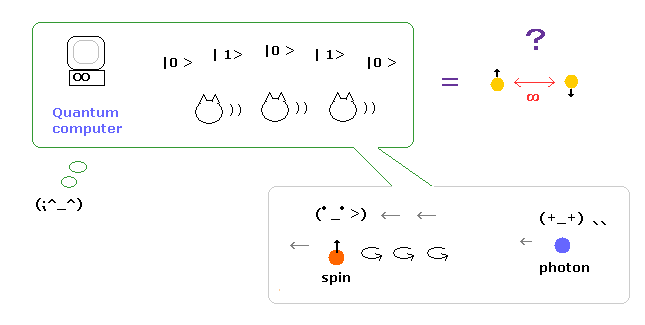
Top page ( correct Bohr model )
Bell iequality violation is illusion.
D-Wave quantum computer is real ?
(Fig.1) "Quantum computer" can be really put to practical use ?

Quantum computer is a dreamy computer, which is said to be much faster than ordinary computers.
Various ( top ) journals, news, and bloggers have appealed to ( or deceive ? ) ordinary people about their usefulness ( ← ? ), extremely many times until now.
But in fact, the researches on quantum computers have already come to a dead end.
In spite of this serious situation, the physicists and journals try to publicize quantum computer massively (= exaggeratedly ).
I explain this reason and impossibility of quantum computing in this page.
(Fig.2) Quantum computer is still "two ions" or josephson circuits ?
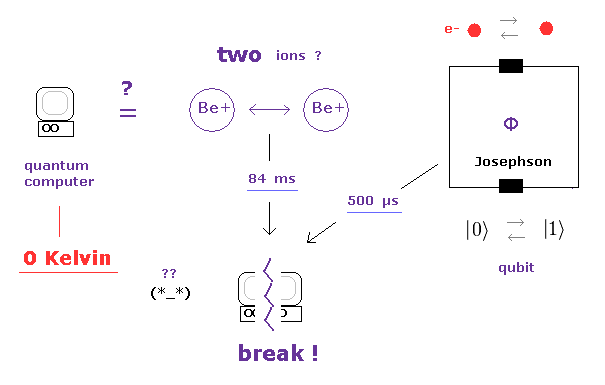
In fact, even now in 2013, "quantum computer" consists ONLY of two ions, or superconducting circuits.
So, at the present, they cannot be called "computer" at all.
( How can you make a computer only from two ions ? Impossible. )
Furthermore, the decoherence ( computer working ) time is only 84 milliseconds in ions, and 500 microseconds in superconducting circuits.
See this news or this.
This means in this extremely short time, quantum computer itself becomes broken.
And to make two ions' motions the same, almost absolute zero temperature is indispensable.
So these are completely impractical and useless as computers ( forever ).
(Fig.3) Reserchers have already given up quantum computers themselves.
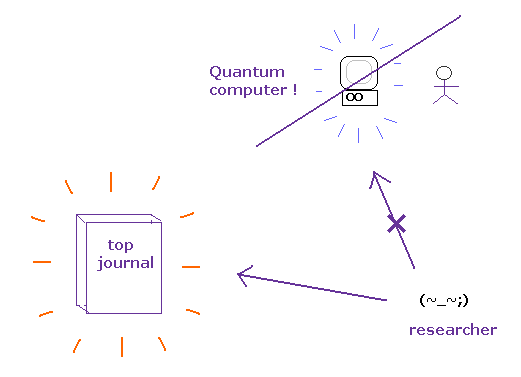
As you find seeing various papers, it is obvious that physicists don't try to put quantum computers themselves to practical use.
Instead, they just aim at publishing their papers in top jounals to get better posts or funding.
In spite of this fact, the specialists in quantum computing repeat ONLY fascinating phrases such as, " Super-fast quantum computer will be practical in several years.", "This is a big step towards a universal quantum computer." But they don't think so at all.
Of course, it is not bad to try to publish papers in top journals or get enough funding.
But now, these are the ONLY motive for quantum-computing research.
This is a serious problem.
(Fig.4) Black hole, string theory, standard model, spin Hall effect .. ← Quantum computer ?
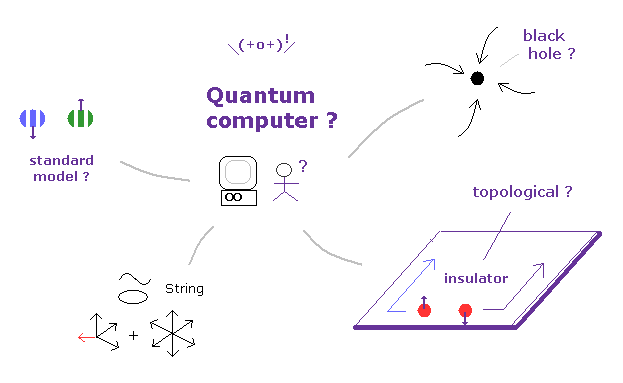
To argue that useless quantum mechanics is useful, physicists needed to create some fictitious target.
One of these artificial targets was, what they call, "Quantum computer".
After that, they abused the word of "quantum computer" as convenient target in various fields.
( black hole, string theory, standard model, spin Hall effect and Berry phase...! )
If you see even ten-dimensional string theory trying to use this quantum computing, you easily understand this quantum computer is completely "fantasy".
(Fig.5) "Superposition" (= many-worlds ), and superluminal "Entanglement" ?
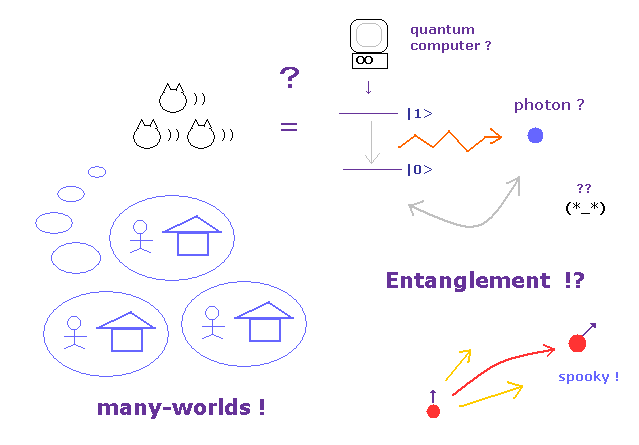
"Superposition" (= many-worlds ) and faster-than-light "entanglement" are the heart of quantum computer.
For example, in Fig.5, some atom has two energy levels (= "0" or "1" ).
If we don't know which state this atom takes, they call this atom's state is "superposition".
The instant we know this energy state, this superposition is broken (= decoherence ).
As you see, this "superposition" means only unknown states, NOT many-worlds at all.
If this atom's is in ground state (= "0" ), photon (= light ) is emitted into the cavity ( see also this section ).
So, presence or absence of a photon inside cavity is entangled with this atom's energy levels, they insist.
Unfortunately, superluminal entanglemnt has NO relation with this phenomena.
(Fig.6) What's the clear mechanism of this faster-than-light entanglement ?
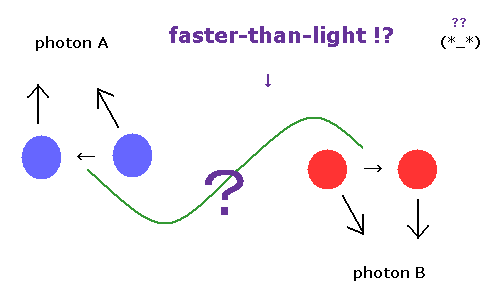
The most serious problem is that they give up pursuing the clear mechanism of entanglement itself.
Because they argue this entanglement is caused by superluminal link, they cannot describe this phenomena using real things, forever.
So, at this point, the development of science completely stops.
"Science" means people continue seeking for true mechanism.
Giving up questioning (= "Shut up and calculate !" ) is NOT true "science".
(Fig.7) They just "manipulate" Be+ ions using "classical" laser.
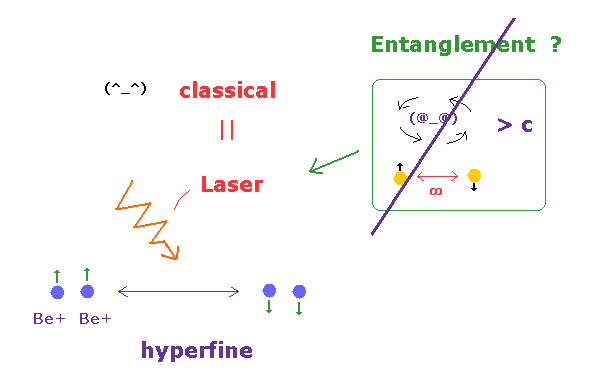
In this paper ( Nature 2001 ), they argue that two beryllium ions are entangled.
But as I say later, this entanglement just means "classical" manipulations of Be+ energy (= hyperfine ) using specific lasers.
By varying radiation time and adjusting circumstances, they can control the transition between two hyperfine states almost as they want.
Of course, this laser pulse is NOT faster-than-light, so entanglement has Nothing to do with it.
Actually, the distance between two ions is ONLY 3 micrometers, so it is impossible to prove faster-than-light relation. (= locality loophole. )
(Fig.8) NMR quantum computer does NOT use "entanglement".
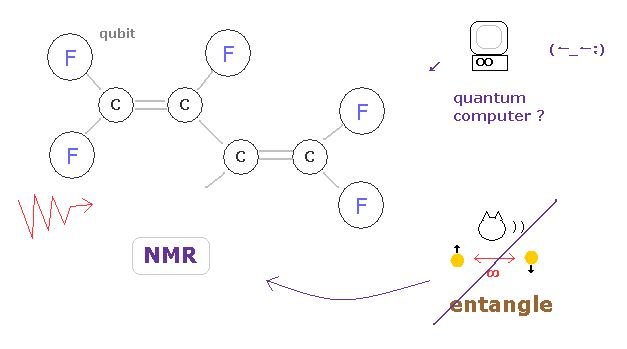
Nucleus has very weak magnetic moment, interacting with surrounding atoms, which splits their energy levels.
They utilized these fine energy splitting as "qubit" of NMR computer, and factorized 15 = 5 × 3, as shown on this page.
In fact, these NMR quantum computers do NOT use "entanglement" (= heart of quantum computer ).
In this paper (p.4) and this paper,
--------------------------
The current NMR experiments should be considered as simulations of quantum computations rather than true quantum computations, since NO entanglement appears.
NMR experiments are separable, i.e. unentangled.
-----------------------------
(Fig.9) 10 billion ions + "spin echo" signals do NOT mean entanglement.
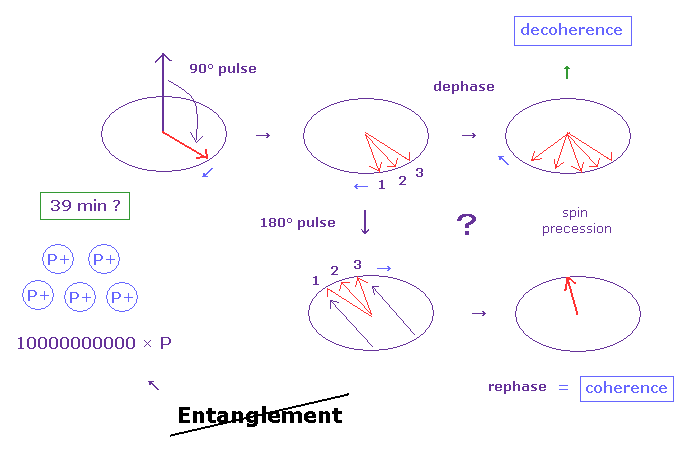
The recent news ( this and this ) say they had succeeded in keeping as much as 39 minutes coherence time at room temperature.
This system contains as many as 10 billion ions.
When some pulse is applied to all ions, almost all of them point toward the same directions.
They just call this state, "coherence" (= superposition !? ), which is also the heart of quantum computer.
If only a part of these extremely many ions turn toward the same, spin echo can be detected, which is considered as coherence state.
They don't see the entanglement of each ion pair. ( Like above NMR. )
This experiment just shows average classcial effects, NOT "mysterious" quantum superposition.
( To be precise, it depends on what they use the word "quantum" to. )
(Fig.10) "Heat" noise is the cause of tunneling.
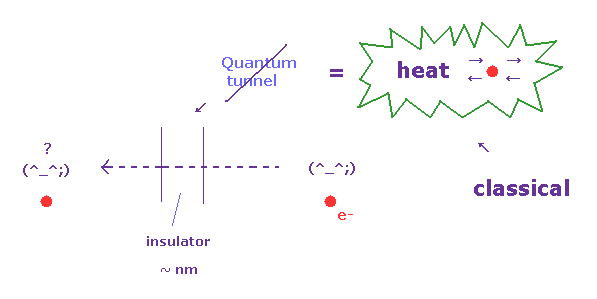
It is said that quantum tunneling is "quantum mechanical" phenomenon where a particle tunnels through a barrier that it classically could not surmount.
The important point is that tunnelling occurs with barriers of thickness less than 1-3 nm. ( ← very thin ! )
As shown on this site and this site, under extremely low temperature, tunneling does NOT occur.
It means "quantum tunnelling" is just caused by some heat noise or something (ex. de Broglie waves ).
(Fig.11) Qunatum tunnel "obeys" classical Coulomb potential (= V ).
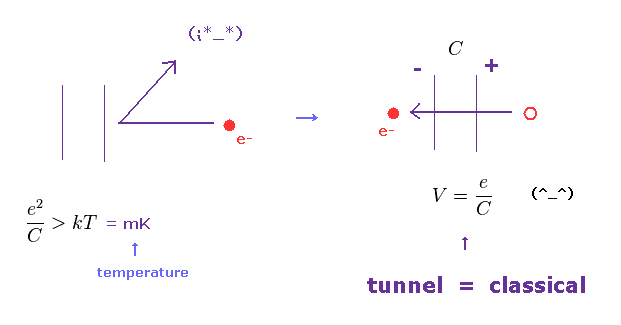
According to Coulomb blockade, when the capacitance of insulator is small, and charging energy ( by a single electron = e2/C ) is larger than temperature, tunnelling itself is blocked.
It means "quantum tunnelling" obeys classical Coulomb potential and thermodynamics.
So we need extremely low temperature ( ~ mK ) to inhibit tunneling.
When a single electron tunnels through thin barrier, it causes classical voltage of V = e/C, so tunneling is blocked (= Coulomb blockade ).
If we apply this voltage, tunnelling can occur.
As a result, Coulomb blockade clearly showed that "tunnel effect" is just classical phenomenon, NOT strange quantum mechanics.
(Fig.12) Why two negative electrons "attract" each other !? →"Shut up !"
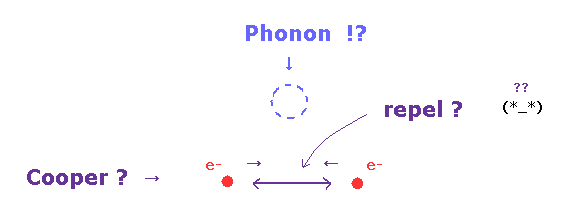
The behavior of superconductor suggests that electron pairs are coupling (= Cooper pair ) over a range of hundreds of nanometers, three orders of magnitude larger than the lattice spacing, as shown on this site.
As you know, two negative electrons usually repel each other, if Coulomb law is right.
This unnatural attractive force between electrons is said to be caused by vague quasiparticle, "phonon".
But this phonon is just virtual quasiparticle, so scientists must clarify what this phonon really is, stopping "Shut up and calculate !".
(Fig.13) Quantized de Broglie wavelength.
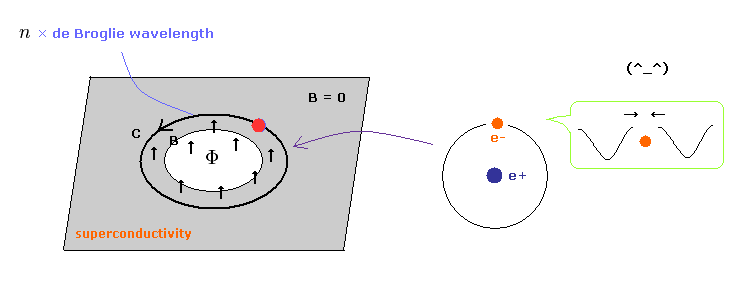
Due to Meissner effect, magnetic field inside superconductor is cancelled out by electron's responding motions ( obeying Lorentz force ).
But inside a hole in a superconductor, an integer times magnetic flux quantum ( Φ = n × Φ0 ) is seen, as shown on this site.
(Eq.1)

As shown on this page, the current quantum mechanics tries to explain this phenomenon by quantized vector potential "A". They insist "2e" of Eq.1 means "Cooper pair".
But they never try to say what the "quantized vector potential" really means.
This troublesome attitude clearly obstructs the development of science.
(Eq.2)

If we suppose each electron is moving obeying Lorentz magnetic force (= F = evB ) and its orbital length is an integer times de Broglie wavelength, we can describe this quantized magnetic flux naturally.
"Cooper pair" disobeying Coulomb law needs NOT to be used.
(Eq.3) ← Eq.2

Solving Eq.2, we get Eq.3 and Eq.4.
(Eq.4) Mgnetic flux quantum by de Broglie wave.
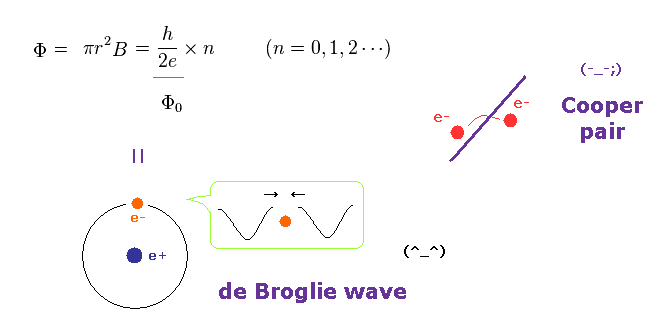
As shown in Eq.4, the magnetic flux (= Φ ) through a hole is just quantized ( Φ = n × Φ0 ).
This is an origin of magnetic flux quantum without invoking Cooper pair.
(Fig.14) Two similar capacitors (= C ) cause "illusory" Cooper pair.
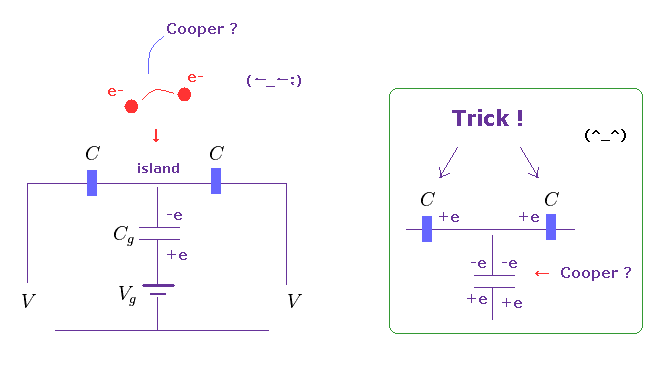
It is said, inside Coulomb island between two similar Josephson junctions (= C ), total charges are quantized based on Cooper pair (= n × "2e" ).
This phenomenon is observed under very special condition of extremely low temperature ( ~ mK ) and low voltage ( V → 0 ).
But as shown in these sites ( this, this, this ), these Coulomb island is always between two ( NOT one ! ) capacitors.
As I explain later (or Fig.14 ), due to these two capacitors, even-numbered charges are always needed.
This is a Trick of Cooper pair box.
(Fig.15) They just see ciritical current change, NOT superposition itself.
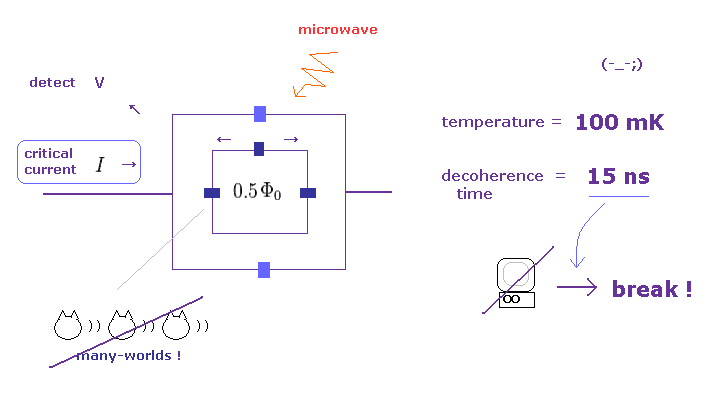
In superconducting flux qubit, when half of magnetic flux quantum (= 0.5 × Φ0 ) is applied, the supercurrents flow clockwise or anticlockwise.
They argure this state indicates mysterious "superposition" ( of two opposite currents ).
But as shown in Science or Nature, they didn't see "superposition" itself.
After applying microwave, they observe the slight change of critical current I around flux qubit.
So this experiment just showed the energy level splitting between two states caused by the opposite currents.
And decoherence time is ONLY 15 nanoseconds at 100 milli-Kelvin.
This means this quantum computer ( if it is ) will easily be broken within only 15 ns. Completely useless.
(Fig.16) Phase qubits are just "classically" oscillating, NOT entanglement.
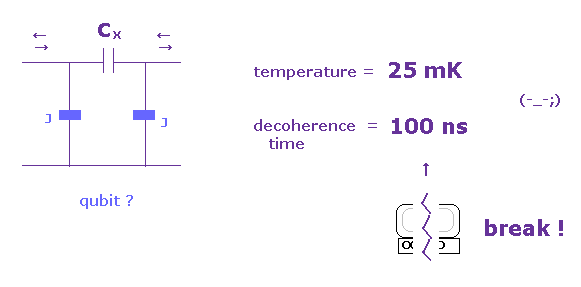
According to Science, two phase qubits ( each has two energy levels ) showed entanglement.
But this entanglement is just classical oscillation, NOT faster-than-light spooky link, as I explain later.
Two qubit circuits are linked by capacitor Cx.
Due to this capacitor and Josephson junctions, currents and charges are going back and forth between two qubits ( for only 100 ns, = "charge oscillation" just after a start ! ).
They just call this oscillation "entanglement", and proved neither superposition nor entanglement itself.
And this entanglement time is only 100 ns, it will be broken in a very short time. Completely useless.
(Fig.17) Quantum computer remains a "dream" (= illusion ), forever.
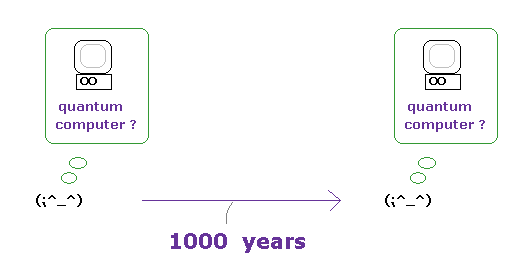
You may have often seen boring phrases such as "superfast quantum computers will come true in ten years or so."
But researches on quantum computing have made NO progress since Alain Aspect's experiment in 1982.
( Only detection efficiency or something is slightly improved. Basic mechanism remains unknown. )
As I said, even now, a quantum computer is still only "two ions".
They needs almost absolute zero, and their decoherence time is only ~1 μs. Completely useless.
But physicists NEVER try to investigate the detailed mechanism of entanglement itself.
As long as they believe strange superluminal link, they have to avoid asking what it really is.
Even 1000 years from now, quantum computer surely remains in a dream in this situation.
(Fig.18) Be+ ion pair is just oscillating by artificial laser.

In this section, we explain the detailed mechanism of entanglement between two beryllium ion (= Be+ ) pair in this paper ( Nature 2001 ).
To begin from the conclusion, these two Be+ ions are only oscillating between two hyperfine states by controlled laser pulse.
This means faster-than-light action has nothing to do with this phenomena.
(Fig.19) Two hyperfine states between nuclear and electron magnetic moments.
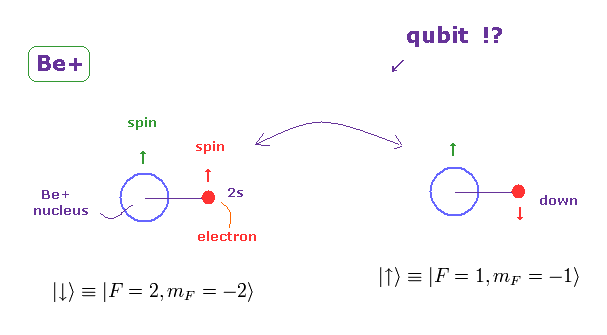
Be+ ion has two hyperfine energy levels.
In one of them, nucleaus and electron's spins point in the same direction.
In another state, their directions are opposite.
(Fig.20) Hyperfine structure is too weak to be used as practical computer.
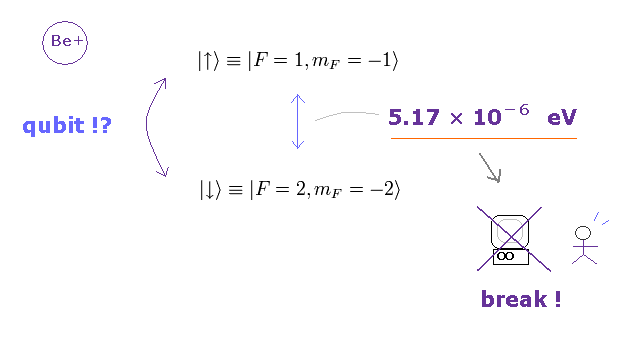
Of course, nuclear spin's magnetic moment is too weak.
So hyperfine structure is very small splitting (= 5.17 × 10-6 eV in Be+ ! )
You easily find if we use this very fragile hyperfine structure as computer bit (= qubit ), this quantum computer will be broken in an instant. Completely useless.
This is one of main reasons why their decoherence ( working ) time is impractically short.
(Fig.21) 2S state (= angular momentum zero ! ) is unrealistic.
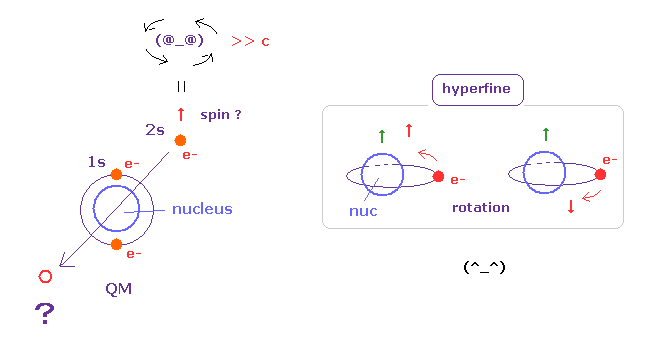
According to strange quantum mechanics, "S" state has NO orbital angular momentum.
This means 2S outer electron of Be+ always crashes into 1S inner electrons and nucleus ? Impossible !
As you notice, this state is very unrealistic.
Electron spin also has Bohr magneton.
So, it is natural that we think hyperfine structure is caused by nuclear spin and orbital motion of electron.
(Fig.22) Be+ ion pair is just oscillating by artificial laser.
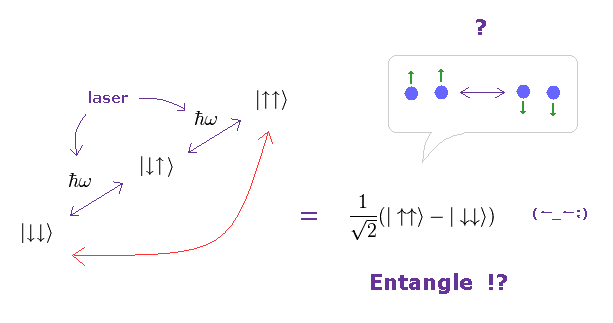
According to this paper and this paper,
They apply two-step lasers to both Be+ ions for enough time to make their spin states the same (= ↑↑ or ↓↓ ).
By detuning the single transition frequency, they tried to avoid single transition (= ↑↓ or ↓↑ ).
So this entanglement between two Be ions are just caused by artificial laser.
Of course, this manipulation (= laser ) is light speed ( NOT superluminal ).
Actually, nonlocal loophohe exists in this trapped ion entanglement.
When they apply tuned laser pulse for short time (= π/2 pulse ), the probability of two states ( = ↑↑ or ↓↓ ) become the same (= mixed), because it takes some time to completely move into another level.
They just call this mixed (= unknown ) state "superposition".
(Fig.23) "Tuned" laser pulse mixes two hyperfine states.
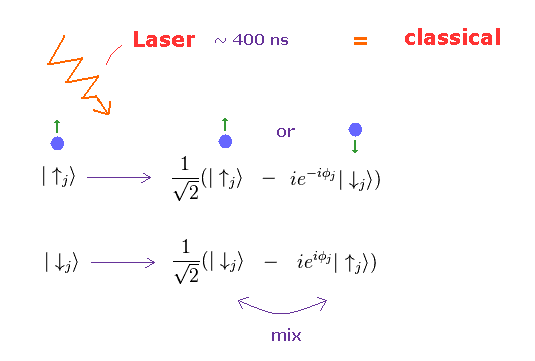
After preparing entangle state of Fig.22, they apply other tuned laser pulse.
If the illuminating time is short, some of them remain the same spin state, and other change into another spin.
Of course, we need to determine this phase φ, "empirically" depending on various conditions.
This manipulation is purely "classical", as this paper insists.
To detect each energy levels, we need to detect many photons, as shown on this page.
So this case is completely different from usual entanglement of photon pair.
Substituting Fig.23 into Fig.22, we obtain
(Eq.5)

and
(Eq.6)

Using Eq.5 and Eq.6, entangled state of Fig.22 changes like
(Eq.7)
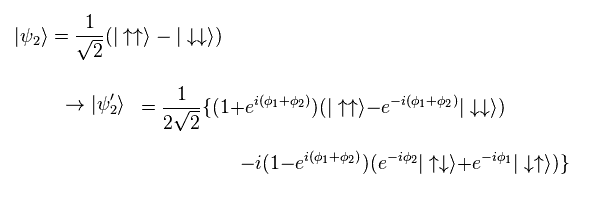
Here we calculate CHSH Bell inequality, as shown on this page.
In this inequality, we first do subtraction;
the probability of the same states (= ↑↑ + ↓↓ ) - the probability of different states (= ↑↓ + ↓↑ ),
(Fig.24) CHSH Bell inequality calculation.
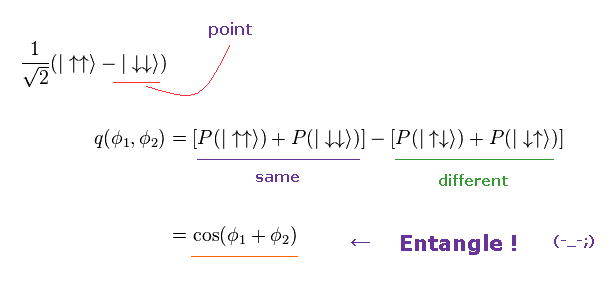
From the coefficients in Eq.7, we get each probability (= P ), as follows,
(Eq.8)

and
(Eq.9)

Here we use
(Eq.10)

Using Eq.8 and Eq.9,
(Eq.11)
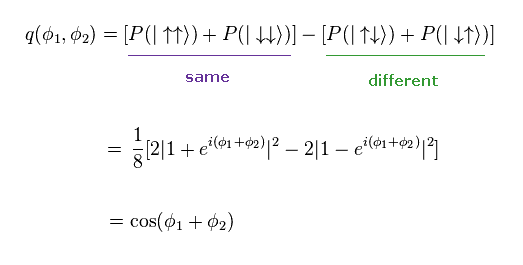
where we use
(Eq.12)
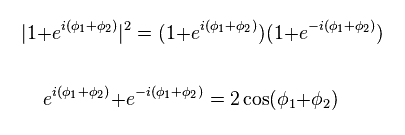
For example, they use the following phases ( which mean "illuminating time" in this case ).
(Eq.13)
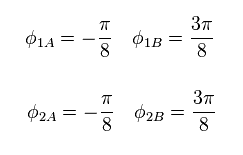
Using Eq.13,
(Eq.14)

As a result,
(Eq.15)
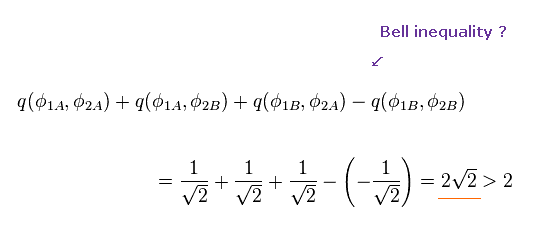
This Bell inequality becomes greater than classical limit of "2" !
So they argue these two Be+ ions are entangled nonlocally (= superluminally !? ).
But of course, this calculation is based on some tricks.
So the superluminal spooky link is just illusion.
(Fig.25) Probability of each states.
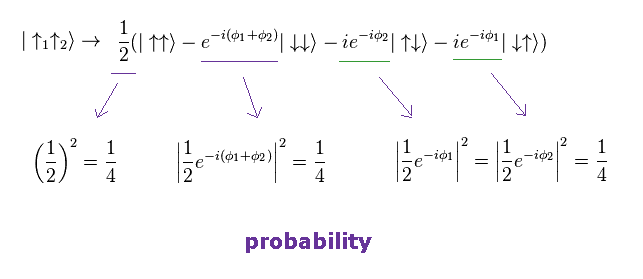
OK. First, we consider ONLY ↑↑ states (= first term of right side ) in Fig.22
From Eq.5, we can know probability of each states, as shown in Fig.25.
As you see, all probabilities become the same "1/4" !
(Fig.26) Only ↑↑ exists. = NOT entanglement.
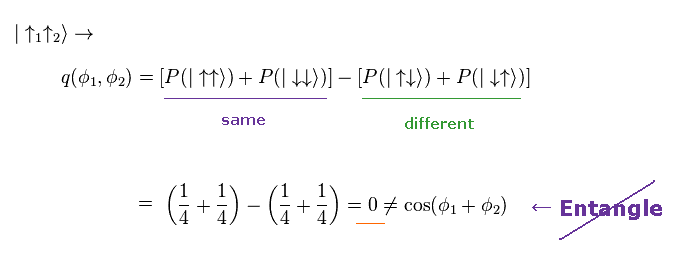
If we use the probability of Fig.25, CHSH result becomes "zero" ( NOT cosine ), as shown in Fig.26.
This means when ONLY one of ↑↑ or ↓↓ exists, Bell inequality is NOT violated ( = classical !? ).
There is an important trick here.
(Fig.27) "1" = one initial state. "2" = two initial staes.
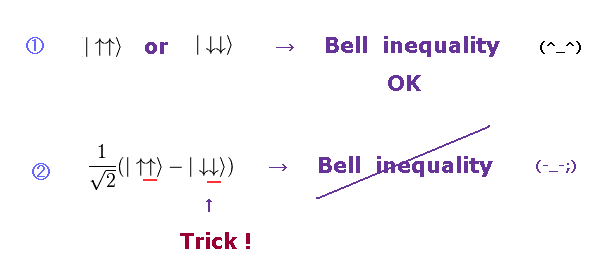
Bell inequality is based on purely classical probability. ( So, violation of it means non-classical. )
According to the classical mechanics, the initial state changes like probability × probability × probability...
If the initial state is only ↑↑, this probability relation (= Fig.28 ) is correctly satisfied.
It means Bell inequality is NOT violated.
(Fig.28) Probability relation.
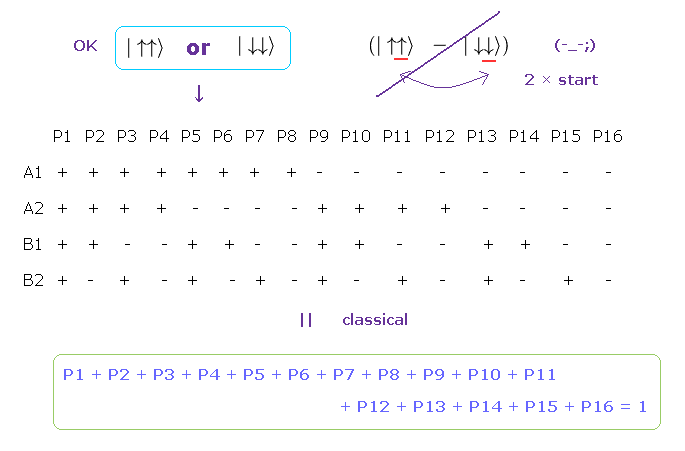
But if one Be+ spin initial state changes depending on another Be+ spin, this means there are two mixed initial states.
It is natural that this mixed state violates Bell inequality.
Because, table of Fig.28 is based on the precondition of one ( NOT two ) common initial state.
So, this case is just classical, NOT entanglement at all.
They just apply Bell inequality to wrong case, as shown in this section.
( This means, Bell inequality cannot be used in this case. )
(Fig.29) Relation between atom's energy level and photon in cavity.
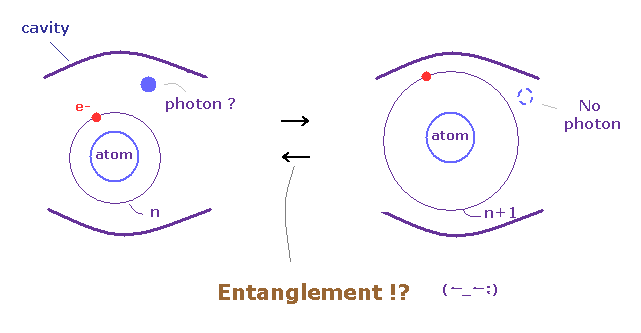
As shown on this site, it is said that an atom is entangled with a photon inside cavity.
The outer electron of Rydberg atom has very high principal quantum number ( n = 20 ~ 40 ).
So this Rydberg atom is very unstable, but they want to use this atom for entanglement.
Cavity-QED can confine light inside it by reflective mirrors.
In Fig.29 left, atom's principal quantum number (= energy level ) is "n", and one photon (= weak light ) is confined inside cavity.
In Fig.29 right, this Rydberg atom absorbs this photon and excited to "n+1" energy level.
So there is NO photon (= energy ) left inside cavity.
(Fig.30) Entanglement is real ?
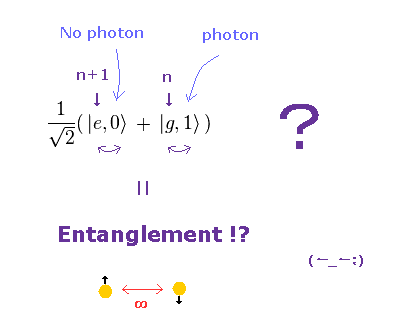
So physicists argure that atom's energy level (= n or n+1 ) and photon number (= 0 or 1 ) are entangled.
As you see, the current quantum physics try to link everything to "fantasy" entanglement.
(Fig.31) 90o (= π/2 ) and 180o (= π ) pulses in NMR
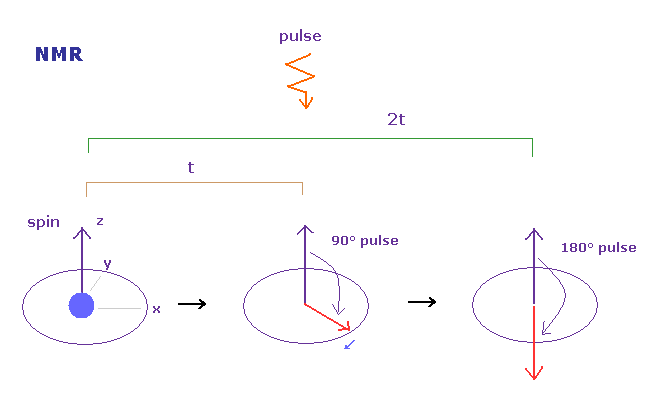
"π/2" and "π" pulses are originally used in NMR.
As shown on this site, when pulse with specific frequency is applied to nuclear spin, this spin direction is changed.
Of course, it takes a little time for each nuclear spin to be flipped.
If this pulse is applied for very short time, spin turns in the horizontal direction with respect to external magnetic field.
This pulse illuminating time is called "π/2" pulse.
If we apply this pulse for twice longer time, nuclear spin is completely flipped.
This pulse time is called "π" pulse.
They strethced this interpretation to general Rabi oscillation.
(Fig.32) Laser pulse changes energy levels.
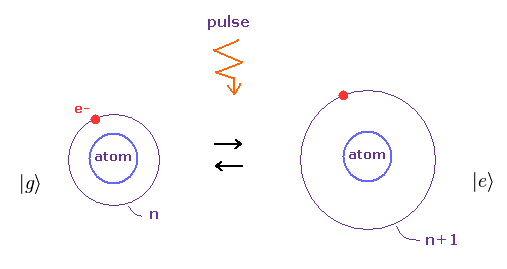
Here we go back to Rydberg atom, again.
In Fig.32, by illuminating atom with pulse laser, energy levels are oscillating between "n" and "n+1" (= Rabi oscillation including "induced" emission ).
They just call this oscillation "superpositon" (= many-worlds ).
But as shown in this site, the relation between "time" and "phase" in Rabi oscillation shows deterministic sinusoidal curve, NOT random.
"Superposition" must be completely random (= God plays dice ), which is inconsistent with Rabi oscillation.
Because Rabi oscillation is the change under some definite rule (= sinusoidal curve ).
(Fig.33) Relation between π/2 and π pulses.
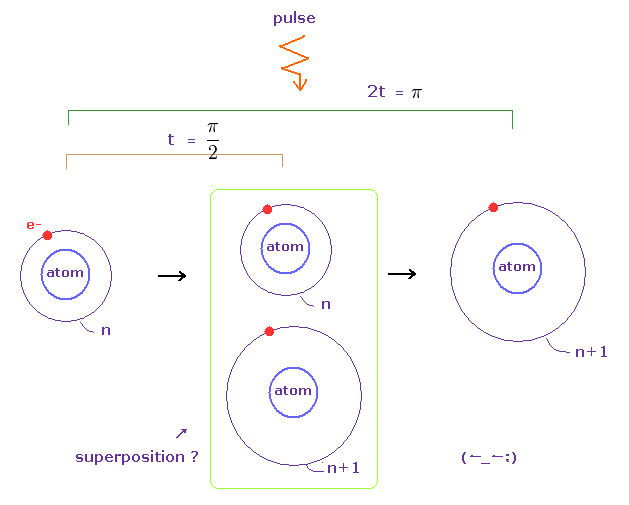
Basically, irradiation time of π/2 pulse is half of π pulse.
If we irradiate an atom for the specific time (= π duration ), the energy levels are completely changed.
( This irradiating time and other conditions must be artificially adjusted. )
So if irradiating time is only half of π pulse ( 1/2 × π ), the probability that the energy level changes is about 50 %.
They like to call this mixed state "superposition", though they are just classically mixed.
(Fig.34) When there are one photon inside cavity, energy level falls into "n".
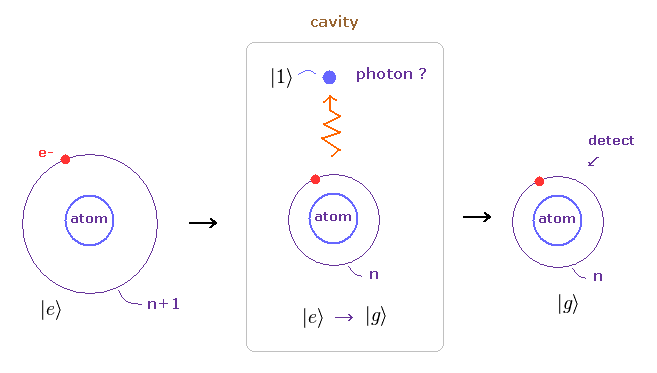
In Fig.34, when this atom emits light (= photon ? ) into cavity, and falls into ground state (= "g" = "n" ), this emitted photon is left (= "1" ) inside cavity.
(Fig.35) When photon is absorbed into atom ..
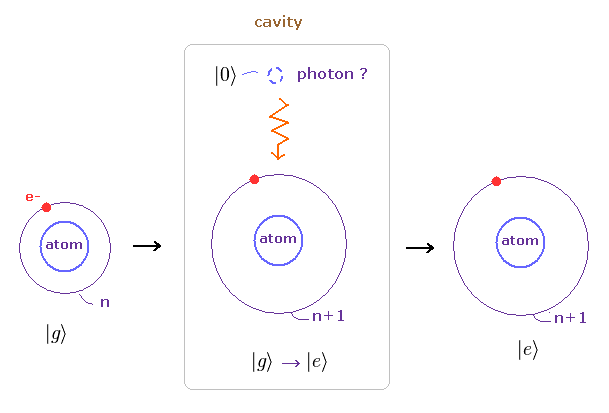
In Fig.35, this emitted photon is absorbed into the atom, again.
As a result, this atom is excited to "e" (= n+1 ), and there is NO photon (= "0" ) inside cavity.
(Fig.36) Entanglement !?
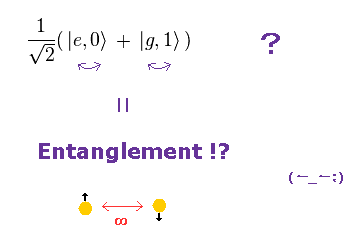
So according to the current quantum mechanics, the two states of Fig.34 and Fig.35 show entanglement between atom and photon.
When atom is excited (= "e" ), no photon left ( "0" ) → "e" - "0" is entangled, they insist.
But as you see, these states are quite natural from the classical viewpoint.
"Superposition" and "entanglement" are completely unnecessary.
(Fig.37) Hamiltonian.
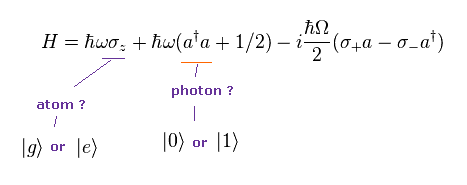
They often describe the Hamiltonian of these states like Fig.37.
Creation (= a† ) and annihilation (= a ) operators denote "photon".
"σ" denote atom's energy states. Pauli matrix.
So, they try to link everything to strange spin direction.
(Fig.38) Time evolution.

Hamiltonian plays a role of time evolution.
As shown in Fig.38, π/2 and π pulse represent phase change after some time.
(Fig.39) The change of charge Q and current I in LC circuit.
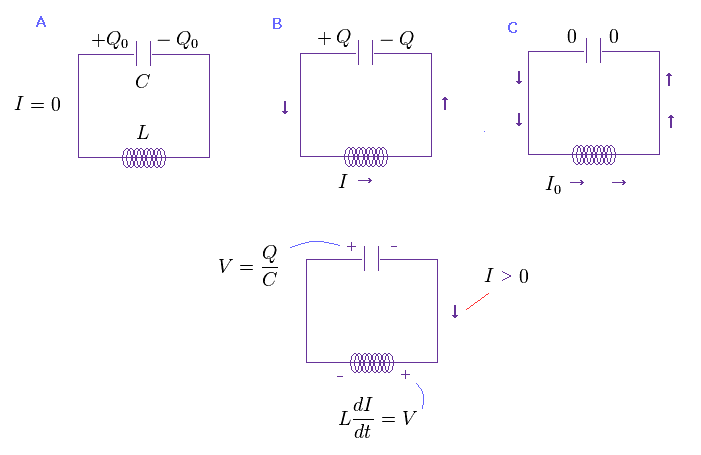
In this section, we consider simple LC circuit consisting of an inductor ( inductance L ) and capacitor ( capacitance C ), as shown on this site and this site.
In Fig.39A, the current I is zero, and charge stored in capacitor C becomes maximum (= Q0 ).
The increase of the current generates voltage in inductor ( V = LdI/dt ).
In Fig.39C, the current becomes maximum (= I0 ).
In this state, voltage in both capacitor and inductor become zero.
As you see, the current is always changing and oscillating in LC circuit.
(Eq.16) Voltage relation.

The voltage of capacitor is "Q/C".
So the relation of Eq.16 is satisfied.
(Eq.17)
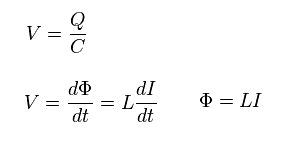
In Fig.17, Φ means magnetic flux through the inductor.
The change of magnetic flux generates voltage.
(Eq.18) Total energy.

Total energy of this LC circuit becomes like Eq.18.
Total energies in Fig.39A and C can be expressed as
(Eq.19) Total energies.

The electric current I is equal to the time derivative of charge Q.
So, Eq.16 becomes
(Eq.20)
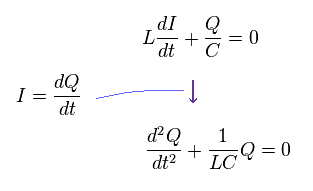
The solution of Eq.20 becomes
(Eq.21)

This ω is frequency of this LC circuit.
But there is ONLY one kind of ω, this simple LC circuit cannot be used as qubits.
On this site (p.3),
-----------------------------
A superconducting LC circuit would NOT work as q-bit, because it has infinitely many evenly-spaced energy levels; resonant driving does not let us single out two levels.
-----------------------------
(Fig.40) Model of Josephson junction.
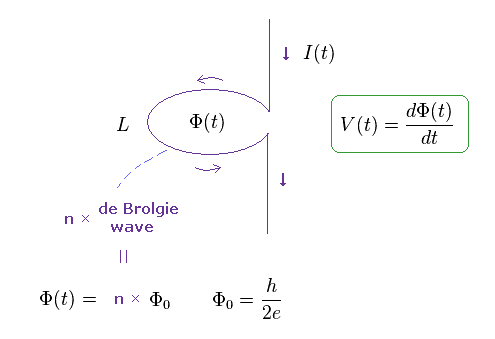
Josephson junction is made of two superconducting electrodes separated by a insulating barrier ( ~ nm ).
It is known that the change of Joseohson current is related to quantized magnetic flux (= Φ0 ).
But the current quantum mechanics cannot give detailed mechanism inside Josephson junction.
Imagine the electric current generates magnetic field inside superconductor.
But due to Meissner effect, this current is ejected by the motion of electrons inside superconductor.
The motion of electron generates de Broglie waves, which tend to become quantized.
This is the origin of magnetic flux quantum, and influences supercurrent oscillation.
(Eq.22)

Eq.22 is Josephson supercurrent I(t).
The phase Φ inside superconductor cannot be directly measured.
( Only the voltage V can be measured. )
(Eq.23)

Josephson junction has the property as inductor.
Inductance L of Eq.23 is always changing, which is different from usual LC circuit.

Using Eq.23 and Eq.24, we can get the total Josephson energy (= EJ ),
(Eq.25)
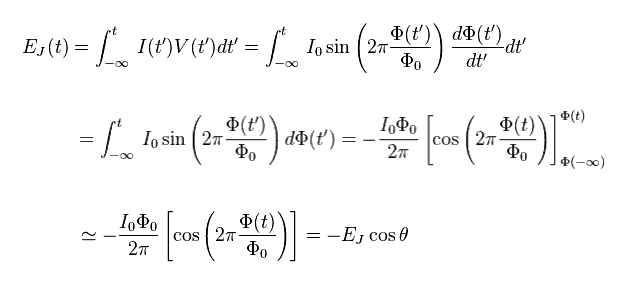
where
(Eq.26)

When the circuit consists of Josephson junction (= CJ ) and capacitor (= Cg ),
(Fig.41)
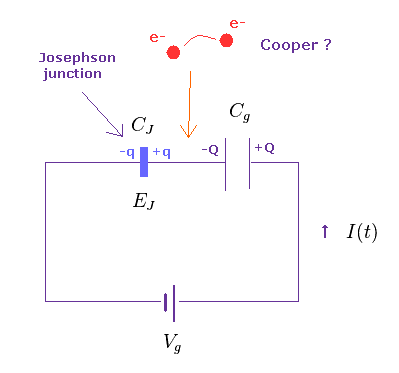
Total energy becomes
(Eq.27)

where
(Eq.28)

"Ng" means the number of Cooper pair (= 2e ), they insist.
(Fig.42) Only Cooper pair (= 2e ) can pass Josephson junction !?
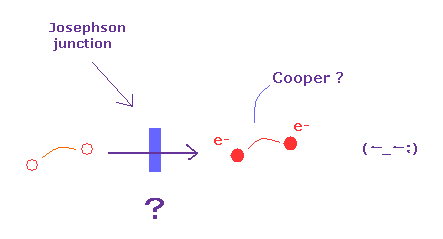
According to BCS theory, two negative electrons must form Cooper pair inside superconductor.
But the detailed mechanism of this strange attractive force remains unknown, due to virtual "phonons".
(Fig.43) Single junction island.
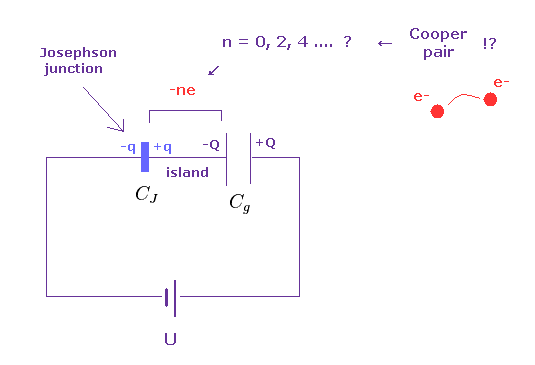
In this paper (Nature), they argue that accumulated charges inside superconducting island are quantized as 2e (= Cooper pair ? ) × n.
To do so, the voltage U and temperature must be extremely low. ( ← very special condition. )
As shown on this site (p.11), capacitances of Josephson junction (= CJ ) and capacitor (= Cg ) are supposed to be almost the same.
(Fig.44) 2e-periodicity ?
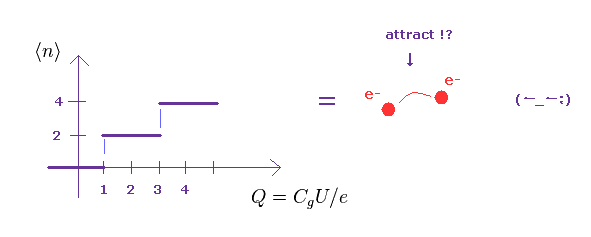
In Fig.44, the transverse line shows charge Q in capacitor.
The vertical line shows the accumulated total charge inside island, they insist.
But of course, we cannot directly measure the number of charges inside island.
(Fig.45) Single electron transistor ( SET, electrometer ).
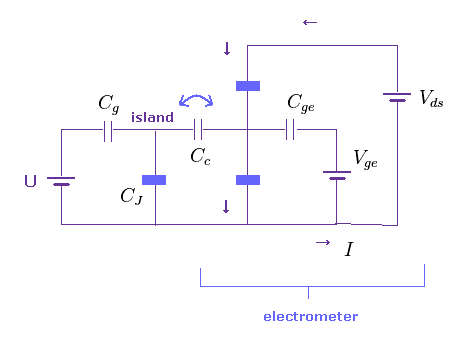
In Fig.45, electrometer is linked to the island through small capacitor Cc.
The change of voltage inside island influences the electric current in electrometer.
Using this electrometer, "2e-periodicity" is observed like Fig.44, they insist.
From Fig.43, total voltage U can be expressed as
(Fig.46)

When charge Q in Fig.44 is "1", this voltage U becomes
(Fig.47)

You can easily find the voltage of Fig.47 is impossible from Fig.46.
(Fig.48)
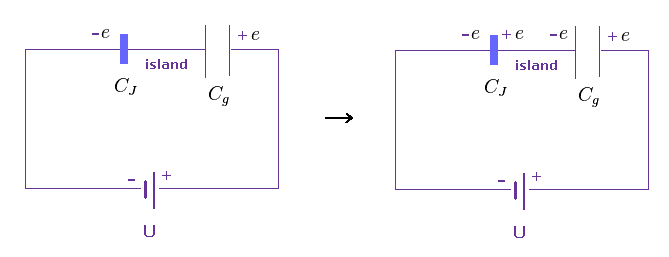
As shown in Fig.48, there are two ( NOT one ! ) capacitors (= CJ and Cg ) in this circuit.
So the minimum "finite" voltage U becomes
(Fig.49)

Fig.49 is inconsistent with Fig.47.
This means "illusory" Cooper pair is caused by two ( NOT one ) capacitors on both sides of island.
(Fig.50)

Trick exists in Two capacitors, Not Cooper pair.
(Fig.51)
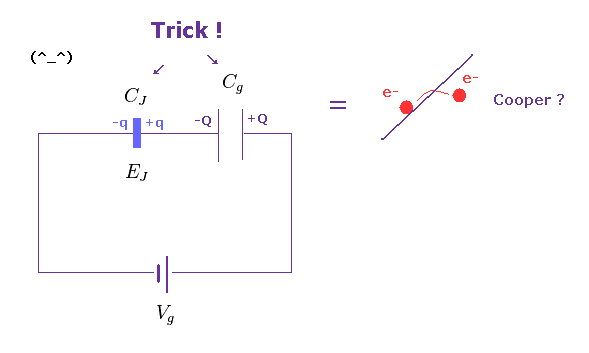
(Fig.52) Cooper pair in Coulomb blockade electrometer ?
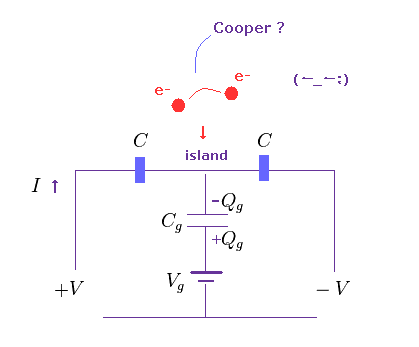
Fig.52 is Coulomb blockade electrometer consisting of two Josephson junctions ( capacitance, C ) and one capacitor ( Cg ).
As shown in this paper (Fig.2) and this paper, the current I shows 2e-periodicity, when the limit of V → 0.
So they insist these 2e-periodic current indicates Cooper pair inside island.
But again, trick exists in two identical junction capacitors (= 2 × C ).
(Fig.53) When there is only one charge (= e ) in Cg capacitor.
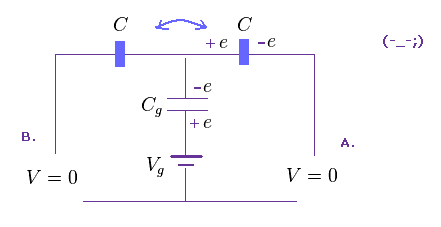
In Fig.53, there is only one charge accmulated at the capacitor Cg ( CgVg = e ).
In this case, the charges inside island becomes unstable, as shown in Fig.53.
(Eq.29)

(Eq.30)

The potentials of both A and B are zero ( V = 0).
If only a single charge exists at one of junctions, potenials of A and B cannot be the same, as shown in Eq.29 and Eq.30.
This is inconsistent.
(Fig.54) Even-numbered charges are accumulated at Cg. ← Cooper pair !?
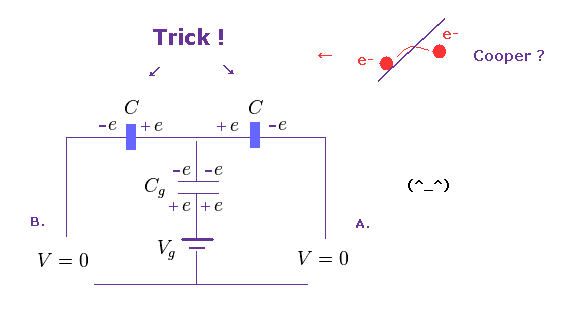
If even charges are accumulated at Cg, the relation between potentials and charges are consistent and stable.
This mechanism ( NOT Cooper pair ) shows 2e-periodic current change.
(Eq.31) Even number is OK.
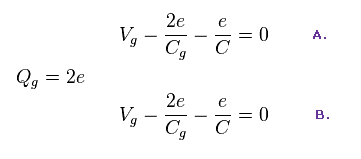
This results shows 2e-periodicity of (bias) current does NOT mean Cooper pair.
This is caused by two identical capacitors of junctions.
When bias voltage becomes slightly bigger, quasiparticle poisoning easily occurs.
So, 1e-periodicity easily appears.
"2e periodicity" is seen ONLY in very special condition.
(Fig.55) "Cooper pair" is going back and forth across junction ?
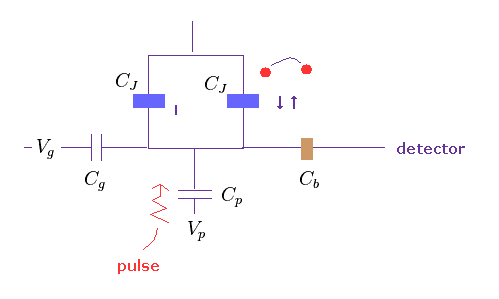
In this paper (Nature), they insist one Cooper pair is oscillating in Cooper pair box.
Of course, it is impossible to directly observe Cooper pair itself.
They just measure some current change at detector.
As I said above, an island of Fig.55 is also surrounded by two identical Josephson junctions.
So, this is one of reasons why "charge oscillation" is seen.
(Fig.56) Pulse voltage causes "classical" ( NOT Cooper pair ) charge oscillation.
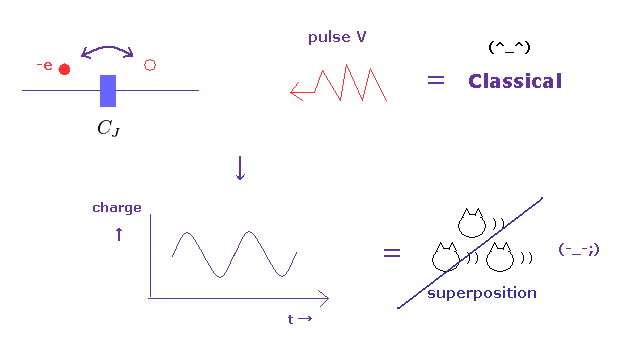
They apply short voltage pulse to the island.
As shown on this site (p.33), individual Cooper pair dacay cannot be detected.
Each oscillation is repeated many times durring one measurement so that there are enough quasiparticle decays to be detected as a current.
(Fig.57) Working time is ONLY 2 ns ?
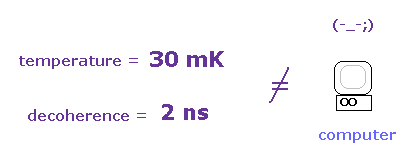
According to this paper, oscillation time is only 2 ns at almost absolule zero (= 30 mK ).
So this charge qubit cannot be used as practical quantum computer at all.
(Fig.58) Charge is oscillating just classically.
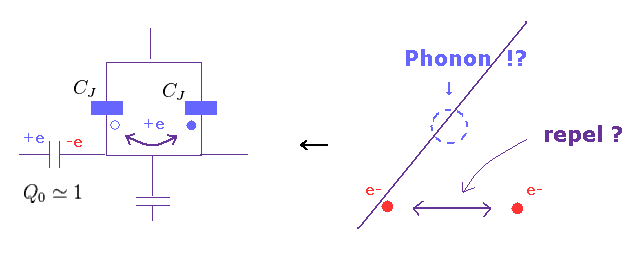
As shown in Fig.58, when only one charge is accumulated at the capacitor ( Q0 = e ), voltage at two junctions are NOT the same.
This state is unstable and inconsistent.
So these charges start to oscillate.
Of course, Josephson junction itself also causes current oscillations.
So phonon and Cooper pair need NOT to be used.
(Fig.59) Charge potential energy.

Fig.59 is charge potential energy at island.
(Fig.60) Accumulated charges.

(Fig.61)

When the accumulated charge Qt is "1", two junctions become unstable, which causes current oscillation.
This is the trick.
(Fig.62) Charge qubit part II.
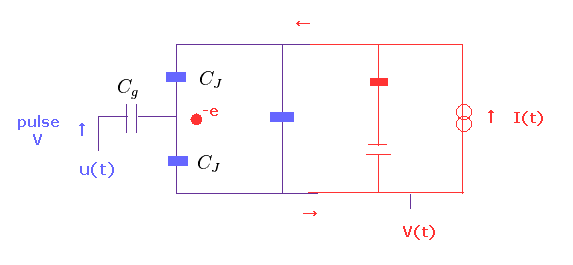
There is another type of charge qubit, as shown in this paper (Science).
Also in this experiment, they cannot directly observe Cooper pair itself.
Of course, it is impossible to see many-wold like superposition itself.
(Fig.63) "Indirect" measurement of Cooper pair ?
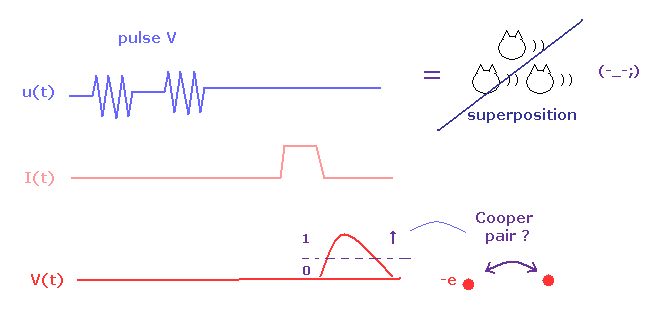
After applying pulse voltage u(t), charges in the circuit start to oscillate.
This is just classical oscillation, NOT superposition at all.
Then, applying read-out current I(t), they detect the change of voltage V(t).
They only suppose bigger amplitude (= above some threshold ) means "Cooper pair".
It's only speculation.
(Fig.64) Mechanism of flux qubit.
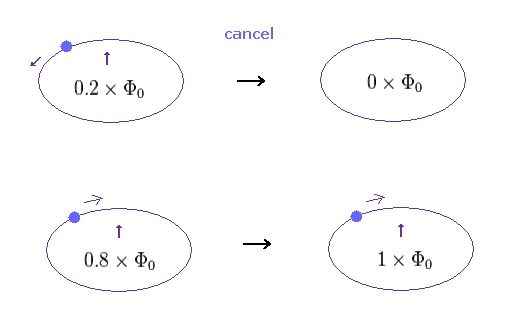
In superconducting flux qubits, two opposite currents are generated, when half of magnetic flux quantum (= 0.5 × Φ0 ) is applied to the loop.
As shown in Fig.64 upper, when 0.2×Φ0 magnetic flux is applied, electron try to cancel this magnetic field to be zero.
But when 0.8×Φ0 is applied, quantized "1×Φ0" flux is closer to the starting flux.
As a result, the electron try to increase this magnetic flux to 1×Φ0.
(Fig.65) "Superposition" of two opposite currents !?
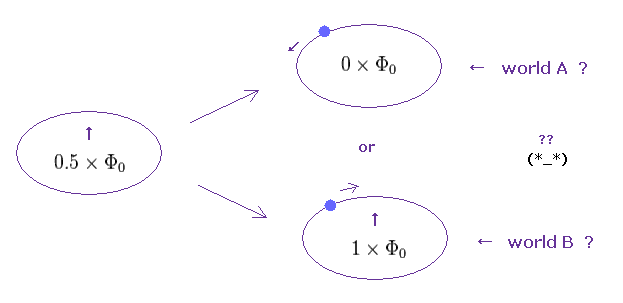
When 0.5 × Φ0 magnetic flux is applied to the loop, both two quantized states are degenerate.
As a result, opposite currents are generated at the same time (= superposition !? ), they insist.
But of course, we cannot observe this strange superposition directly.
This is just speculation, too.
(Fig.66) Flux qubit and SQUID.
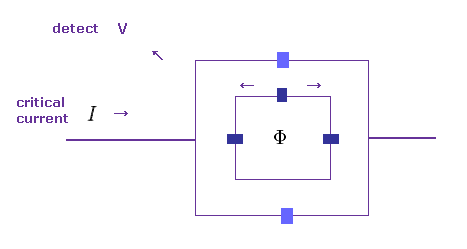
In this paper (Science), inner loop is flux qubit, in which two opposite currents are flowing, they insist.
And outer loop (= DC-SQUID ) is used as indirect detector.
If bias current I is bigger than some critical point, voltage V is detected.
(Fig.67)
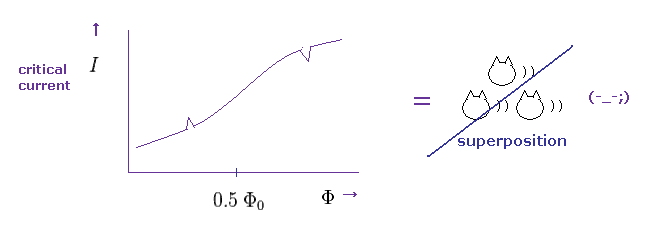
According to their insistence, when microwave is applied to these loops, a peak and dip is seen in Fig.67.
This peak and dip indicate the current direction is changed.
At the point of 0.5 × Φ0, two states are degenerate (= energy difference is zero ), so these peak and dip are not seen.
They just call the graph of Fig.67 "superposition", but it's only speculation, again.
(Fig.68) Very fragile qubits.
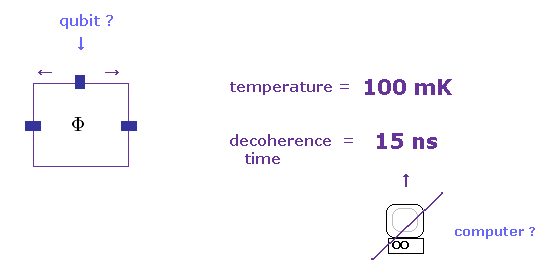
The decoherence time of this flux qubit is only 15 ns at 100 mK.
Again, this superconduncting qubit is completely impractical.
(Eq.32)

SQUID consists of two Josephson junctions, as shown on this site and this site
The same current of the same direction flows through these junctions.
As a result, total current I becomes
(Eq.33)
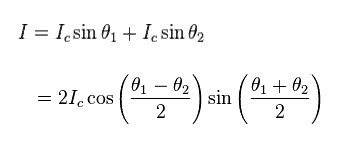
where
(Eq.34)

From Eq.33 and Eq.34, we have
(Eq.35)

(Fig.69) Phase qubits A and B are entangled !?
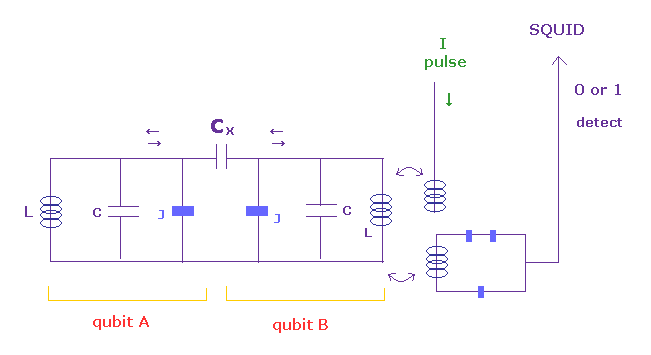
In phase qubits ( Science ), they utilize very small energy splitting caused by capacitors, Josephson junctions and inductors.
Different from simple LC circuit, there are many kinds of frequencies.
So by using only specific light frequency, they can control definite energy states.
They use two of their energy levels as qubits (= "0" or "1" ).
Of course, these energy levels are very artificial.
By adjusting various current I and voltage, these frequencies are changed and conrolled.
(Fig.70) Classical oscillation = entanglement.
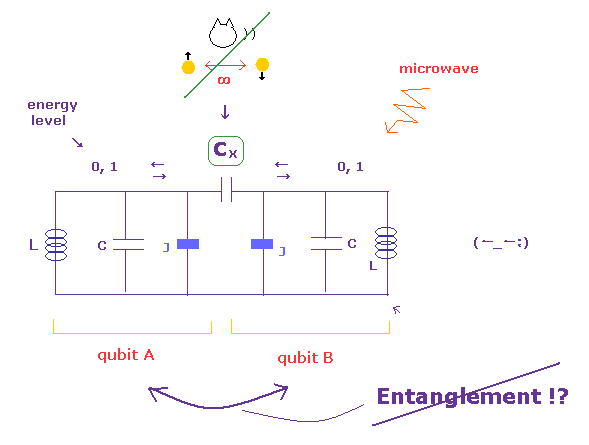
By applying microwave to one of circuits (= qubits ), its energy state is excited ( "0" → "1" ).
When they link two circuits through capacitor Cx, each current and energy states are oscillating between two circuits ( for only very short time, 100 ns ).
When one circuit's energy is "0" (= ground state ), another circuit is "1", due to energy conservation .
They call this relation of "01" or "10", "engtanglement".
But this result only shows classical current oscillation.
(Fig.71) Very fragile qubits.

The decoherence time of this phase qubit is only 100 ns at 25 mK.
So this superconducting qubit cannot be applied to actual computer at all, either.
(Ap.1) Probability table holds for Be+ ion pair ?
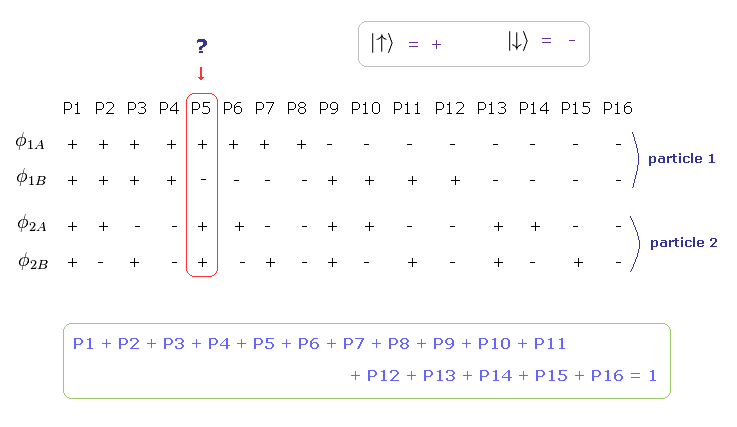
To satisfy Bell inequality, probability table like Ap.1 must hold.
In Ap.1, if we determine four variables (= φ1A, φ1B, φ2A, φ2B ), each probability ( for example "P5" ) gives unique (= single ) value.
But in above Be+ ion case, this P5 cannot be unique.
Because, it has mixed initial states.
(Ap.2) "P5" probability can be determined "uniquely" ?
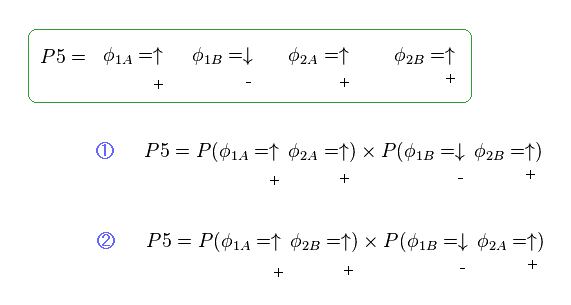
The probability P5 can be expressed in two kinds of ways (= "1" and "2" ).
Of course, to satisfy Ap.1 and Bell inequality, these two P5 must be the same.
(Ap.3)

But in above Be+ case, these two P5 give different values !
(Eq.8)

(Eq.9)

Using Eq.8 and Eq.9, the first P5 (= "1" ) becomes
(Ap.4)
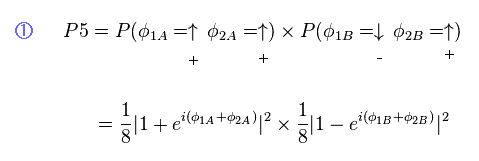
Here we use the following condition.
(Ap.5)

Substituting Ap.5 into Ap.4, we have
(Ap.6)
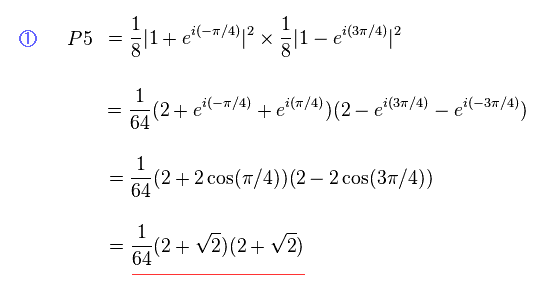
Here we use
(Ap.7)

The second P5 (= "2" ) in Ap.2 is
(Ap.8)
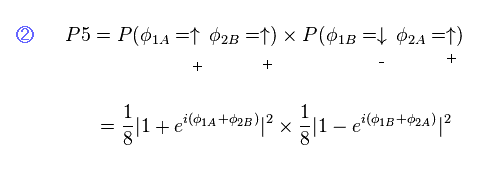
Substituting Ap.5 into Ap.8, we have
(Ap.9)
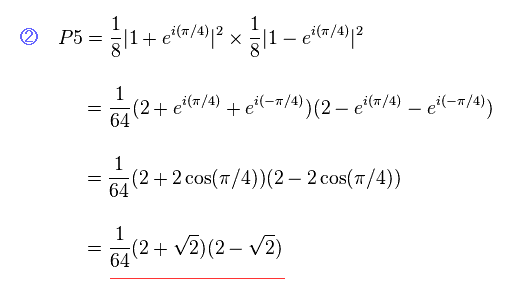
Comparing Ap.6 (= 1" ) and Ap.9 (= "2" ), you find two kinds of P5 become different !
(Ap.10)

This means we cannot define table of Ap.1.
So Bell inequality is violated.
But of course, superluminal entanglement has Nothing to do with this Be+ ion case.
They only misuse Bell inequality.

2014/4/13 updated. Feel free to link to this site.